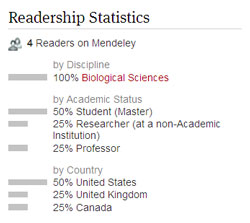 The first step when starting any new research project is to become familiar with the past literature, and know who did what, and when. This is especially true for taxonomy, where each and every paper published in the past 250 years regarding the description of new species or discussion of the framework for the tree of life for any given taxon is relevant and needs to be examined. This can result in a huge library of publications to keep track of, for which there are a number of options available to the beginning biologist.
The first step when starting any new research project is to become familiar with the past literature, and know who did what, and when. This is especially true for taxonomy, where each and every paper published in the past 250 years regarding the description of new species or discussion of the framework for the tree of life for any given taxon is relevant and needs to be examined. This can result in a huge library of publications to keep track of, for which there are a number of options available to the beginning biologist.
One in particular however, has something a little extra incorporated in it; a social network.
Mendeley was developed as a freely available, online, cloud-based reference manager, where individual users add citations & publications to a central repository, which in turn is accessible to all other users for building citation catalogs of their own. There are several benefits to this system, one of which is a recommendation of other publications which may be relevant to your field of research, some of which you may not have been previously aware of. The other benefit is of more use for evaluating the impact of a publication (including your own).
Because all 1 million current users are building citation lists from the same pool, it’s possible to obtain basic demographics of the people reading your work. Take for example a recent paper I collaborated on regarding PCR primers specific for Diptera phylogenetics. 3 people (other than myself) have added the paper to their Mendeley citation list, with 2 working in the US and one in the UK. While these aren’t groundbreaking numbers, nor the stats overly informative, it’s encouraging to see researchers are noticing the work we did. I would like it if you could see who exactly was reading your papers, as I think it could be useful for finding future collaborators or potential advisors for graduate or post-doctoral work, but I’ll take the simple gratification that our work is being read by 0.0003% of the Mendeley community!
Mendeley has also incorporated several other networking tools, including profiles where you can share your CV, publications, funding sources and contact information (similar to the tools available to LinkedIn users), as well as infrastructure for sharing publications and holding discussions specific to your field of research in both public and private groups. Being based primarily online, it’s pretty simple to add references to your library using available web browser add-ons, and there are also desktop & mobile clients available which allow you to access your reference library anywhere or while on the go, although I’ve found them both to be a little buggy and prone to crashing (on my iPhone 4S and Windows XP PC).
The central citation database built by the community of users also holds the potential for some interesting data-mining projects, like Roderic Page’s goal of linking species names with the literature containing their original description. If you’re interested in cybertaxonomy, I’d recommend checking out Rod’s blog for more information (it’s pretty cool, but a little on the technical side).
Ultimately, Mendeley is attempting to streamline the accumulation and distribution of scientific literature for researchers. If you’re looking for a reference manager, or are interested in exploring some of it’s capabilities, feel free to look me up; who knows how we might connect!
Gibson, J. F., Kelso, S., Jackson, M. D., Kits, J. H., Miranda, G. F. G., & Skevington, J. H. (2011). Diptera-Specific Polymerase Chain Reaction Amplification Primers of Use in Molecular Phylogenetic Research. Annals of the Entomological Society of America, 104(5), 976-997. Available online (OPEN ACCESS)

